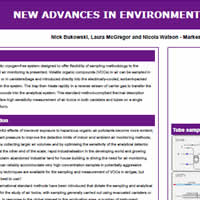Resumo do Pôster:
1. Introduction
As the harmful effects of low-level exposure to hazardous organic air pollutants become more evident, there is constant pressure to improve the detection limits of indoor and ambient air monitoring methods; for example, by collecting larger air volumes and by optimising the sensitivity of the analytical detector.
However, at the other end of the scale, rapid industrialisation in the developing world and growing pressure to reclaim derelict industrial land for house building is driving the need for air monitoring methods that can reliably accommodate very high concentration samples in potentially aggressive matrices. Many techniques are available for the sampling and measurement of VOCs in air/gas, but which are the best to use?
Several international standard methods have been introduced that dictate the sampling and analytical methodology for the study of air toxics, with sampling generally carried out using evacuated canisters or sorbent tubes. In response to the global interest in this application area, a number of instrument developments have been made to address this analysis. This work describes a cryogen-free analytical system designed to offer flexibility of sampling methodology, fully compliant with US EPA Methods TO-15 (canisters)1 and TO-17 (sorbent tubes)2.
2. Purpose
Present instrument developments that have been made to address VOCs analysis in air/gas.
3. Method
The system used is compatible with canisters and sorbent tubes, and is composed by an automatic cryogen-free thermal desorber instrument in conjunction with a tube autosampler. This features sample re-collection onto tubes, which enables repeat analysis for method validation purposes. An added capability to introduce vapour-phase internal standards onto sorbent tubes (or directly onto the pre-concentration trap in the case of canister analysis) ensures optimum reproducibility, a robust method and integrity of results. Furthermore, switching from larger-volume sampling to small-volume sampling using an integrated sample loop facilitates analysis of both high- and low-concentration samples. Developments in thermal desorption (TD) technology allow this ‘High/Low’ analysis to be performed with minimal need to run intersample blanks, maximising sample throughput.
Metered by gas loop or mass flow controller, each air/gas sample is introduced directly into the electrically-cooled, sorbent-packed focusing trap. Sorbents and trapping temperatures are optimised for retention of organic components and simple/effective elimination of water and CO2. The trap then heats rapidly in a reverse stream of carrier gas to transfer the retained compounds into the analytical system. This transfer can be performed splitless for maximum sensitivity. Negligible carryover and the inherent concentration flexibility of the system also mean that ambient air samples can be directly calibrated with small volumes of relatively inexpensive higher-concentration standards if required.
4. Results and Discussion
The system used in this work offers features like leak-testing of tubes, internal standard addition, and the ability to re-collect split flow for repeat analysis/method validation (Figure 1) that ensure full compatibility with standard methods and provide confidence in analytical results. Furthermore, the diffusion-locking end-caps used to seal tubes before, during and after analysis prevent the ingress or loss of volatiles.
As evidenced by Methods TO-15 and TO-17, both canisters and sorbent tubes are compatible with air toxics in typical ambient concentrations i.e. at 0.1 to 25 ppb levels. However, for compounds outside the methylchloride to hexachlorobutadiene range and for other air monitoring applications there are differences between the two sampling methods (Figure 2) which can make one technology more suitable than the other for a particular situation. In effect, canisters and sorbent tubes provide complementary sampling technology.
Because of the analyser modular design and the availability of a wide range of associated sampling accessories, the system presented is compatible with both canister/bag and sorbent tubes analysis, allowing a wider range of applications, such as TO-17 air toxics, SVOCs and passive sampling.
5. Conclusion
As well as providing a high degree of analytical quality over the full range of canister and tube compatible applications, the thermal desorber with the tube autosampler presented offers cryogen-free operation, and provides the analyst with a number of tools to ensure confidence in the analytical method and results obtained.
6. References
- US EPA Method TO-15 (and its predecessor TO-14) Determination of volatile organic compounds in air collected in SUMMA canisters and analyzed by GCMS.
- US EPA Method TO-17 Determination of volatile organic compounds in ambient air using active sampling onto sorbent tubes.
|

